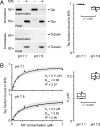Tau repeat regions contain conserved histidine residues that modulate microtubule-binding in response to changes in pH
- PMID: 30992364
- PMCID: PMC6552421
- DOI: 10.1074/jbc.RA118.007004
Tau repeat regions contain conserved histidine residues that modulate microtubule-binding in response to changes in pH
Abstract
Tau, a member of the MAP2/tau family of microtubule-associated proteins, stabilizes and organizes axonal microtubules in healthy neurons. In neurodegenerative tauopathies, tau dissociates from microtubules and forms neurotoxic extracellular aggregates. MAP2/tau family proteins are characterized by three to five conserved, intrinsically disordered repeat regions that mediate electrostatic interactions with the microtubule surface. Here, we used molecular dynamics, microtubule-binding experiments, and live-cell microscopy, revealing that highly-conserved histidine residues near the C terminus of each microtubule-binding repeat are pH sensors that can modulate tau-microtubule interaction strength within the physiological intracellular pH range. We observed that at low pH (<7.5), these histidines are positively charged and interact with phenylalanine residues in a hydrophobic cleft between adjacent tubulin dimers. At higher pH (>7.5), tau deprotonation decreased binding to microtubules both in vitro and in cells. Electrostatic and hydrophobic characteristics of histidine were both required for tau-microtubule binding, as substitutions with constitutively and positively charged nonaromatic lysine or uncharged alanine greatly reduced or abolished tau-microtubule binding. Consistent with these findings, tau-microtubule binding was reduced in a cancer cell model with increased intracellular pH but was rapidly restored by decreasing the pH to normal levels. These results add detailed insights into the intracellular regulation of tau activity that may be relevant in both normal and pathological conditions.
Keywords: Tau protein (Tau); cancer biology; histidine; intracellular pH; intrinsically disordered protein; microtubule; microtubule-associated protein (MAP); molecular dynamics; neurobiology; neurodegeneration; neuronal cytoskeleton; pH sensing; protein–protein interaction.
© 2019 Charafeddine et al.
Conflict of interest statement
The authors declare that they have no conflicts of interest with the contents of this article
Figures







Similar articles
-
Tau stabilizes microtubules by binding at the interface between tubulin heterodimers.Proc Natl Acad Sci U S A. 2015 Jun 16;112(24):7501-6. doi: 10.1073/pnas.1504081112. Epub 2015 Jun 1. Proc Natl Acad Sci U S A. 2015. PMID: 26034266 Free PMC article.
-
Identification of a novel microtubule binding and assembly domain in the developmentally regulated inter-repeat region of tau.J Cell Biol. 1994 Mar;124(5):769-82. doi: 10.1083/jcb.124.5.769. J Cell Biol. 1994. PMID: 8120098 Free PMC article.
-
Functional interactions between the proline-rich and repeat regions of tau enhance microtubule binding and assembly.Mol Biol Cell. 1997 Feb;8(2):353-65. doi: 10.1091/mbc.8.2.353. Mol Biol Cell. 1997. PMID: 9190213 Free PMC article.
-
Regulation of neuronal microtubule dynamics by tau: Implications for tauopathies.Int J Biol Macromol. 2019 Jul 15;133:473-483. doi: 10.1016/j.ijbiomac.2019.04.120. Epub 2019 Apr 17. Int J Biol Macromol. 2019. PMID: 31004638 Review.
-
Structural insights into Alzheimer filament assembly pathways based on site-directed mutagenesis and S-glutathionylation of three-repeat neuronal Tau protein.Microsc Res Tech. 2005 Jul;67(3-4):156-63. doi: 10.1002/jemt.20195. Microsc Res Tech. 2005. PMID: 16104002 Review.
Cited by
-
Tau Inclusions in Alzheimer's, Chronic Traumatic Encephalopathy and Pick's Disease. A Speculation on How Differences in Backbone Polarization Underlie Divergent Pathways of Tau Aggregation.Front Neurosci. 2019 May 15;13:488. doi: 10.3389/fnins.2019.00488. eCollection 2019. Front Neurosci. 2019. PMID: 31156372 Free PMC article.
-
VEGF and VEGFR2 bind to similar pH-sensitive sites on fibronectin, exposed by heparin-mediated conformational changes.J Biol Chem. 2021 Jan-Jun;296:100584. doi: 10.1016/j.jbc.2021.100584. Epub 2021 Mar 24. J Biol Chem. 2021. PMID: 33771558 Free PMC article.
-
Neurological Diseases can be Regulated by Phase Separation.Rev Physiol Biochem Pharmacol. 2025;187:273-338. doi: 10.1007/978-3-031-68827-0_16. Rev Physiol Biochem Pharmacol. 2025. PMID: 39838017 Review.
-
Doublecortin reinforces microtubules to promote growth cone advance in soft environments.Curr Biol. 2024 Dec 16;34(24):5822-5832.e5. doi: 10.1016/j.cub.2024.10.063. Epub 2024 Dec 2. Curr Biol. 2024. PMID: 39626666
-
Reversible and size-controlled assembly of reflectin proteins using a charged azobenzene photoswitch.Chem Sci. 2024 Jul 17;15(33):13279-13289. doi: 10.1039/d4sc03299c. eCollection 2024 Aug 22. Chem Sci. 2024. PMID: 39183923 Free PMC article.
References
Publication types
MeSH terms
Substances
Associated data
- Actions
Grants and funding
LinkOut - more resources
Full Text Sources
Research Materials

